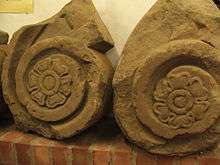Arnold of Altena
Arnold of Altena, count of Altena, count of Isenberg and Hövel, Vogt of Werden (1166–1209) was son of Eberhard IV of Berg. He inherited the north-western territorium of Altena, and became 1st count of Isenberg in 1200.

The Isenberger Rose was the coat of arms of Friedrich von Isenberg. It had been adopted by his father, Arnold of Altena.
He married Mechtild countess of Holland and Styrum, a daughter of Floris III, Count of Holland. They had issue:
- Eberhard II count of Altena and Isenberg (born 1180, died 1209)
- Friedrich II of Isenberg, count of Altena and Isenberg (d. beheaded at Cologne 13 Nov 1226);
- Dietrich of Altena, Prince-Bishop of Münster (born before 1180, died on the way back from Rome to Limburg 18 Jul 1226);
- Engelbert of Altena, Prince-Bishop of Osnabrück (1224-deposed 1226 following his implication in Engelbert II of Berg's assassination, rehabilitated 1238-1250) (born before 1200, died 1250);
- Philipp of Altena, Propst zu Soest and Domthesaurar in Cologne (born before 1200, died 1264);
- Bruno of Altena, Prince-Bishop of Osnabrück (1250–1259) (born before 1200, died 20 December 1258);
- Gottfried of Altena, Propst zu St. Martin and Domdechant in Münster (born before 1220, died after 1247);
- Adolf von Holte (born 1220, died before 25 Jan. 1260), married to Elisabeth von Holte (died after 1260). They had issue:
- Heinrich von Holte, a prior in Cologne (fl. 1261/89);
- Arnold von Holte, a priest (fl. 1266);
- Wilhelm von Holte, a priest (fl. 1281);
- Mechtild von Holte, heiress of Holte and Morenhoven (died 1301), married to Gerhard von Arberg, Bggf von Köln (d. 1287);
- Heilwig (fl. 1237/46), married to Wilhelm I von Horn; and
- Christina (fl. 1257), married to Albero Schalle;
- Wilhelm of Altena, also called Wilhelm of Isenberg (1223-1242). He had a son, Wilhelm (fl. 1275), married to Christina NN;
- NN, a daughter, married to Hermann of Altena.
- Agnes of Altena, a daughter, married to Christian III, Count of Oldenburg.
Literature
- Genealogische Handbuch des Adels, Gräfliche Häuser A Band II, 1955;
- W. Gf v. Limburg Stirum, "Stamtafel der Graven van Limburg Stirum", 's Gravenhage 1878;
- A.M.H.J. Stokvis, "Manuel d'Histoire, de Genealogie et de Chronologie de tous les États du Globe", Tome III, Leiden 1890-93;
- W. K. Prins v. Isenburg, "Stammtafeln zur Geschichte der Europaischen Staaten", 2. Aufl., Marburg/Lahn, 1953.
gollark: I was using nano and that was easier.
gollark: I can just nest VMs.
gollark: I just compiled a Rust program, see.
gollark: Oh, it needs proc, how annoying.
gollark: I AM INSTALLING RUST, MUAHAHAHA.
This article is issued from Wikipedia. The text is licensed under Creative Commons - Attribution - Sharealike. Additional terms may apply for the media files.